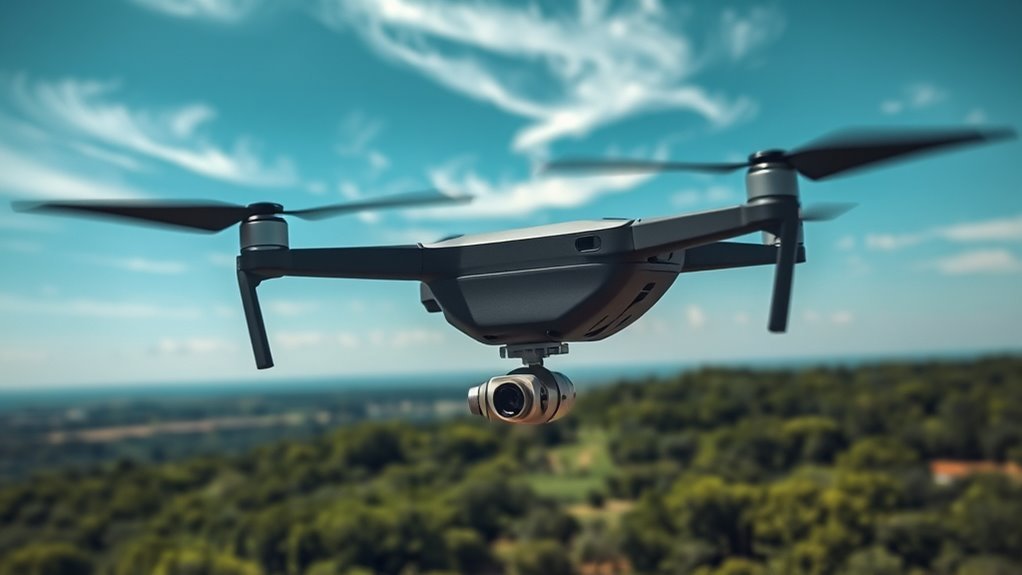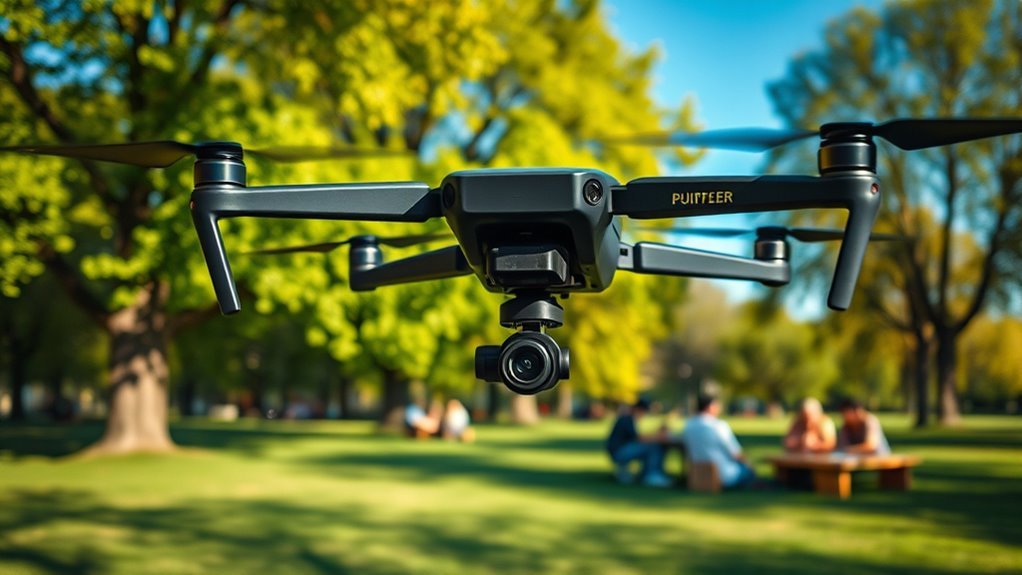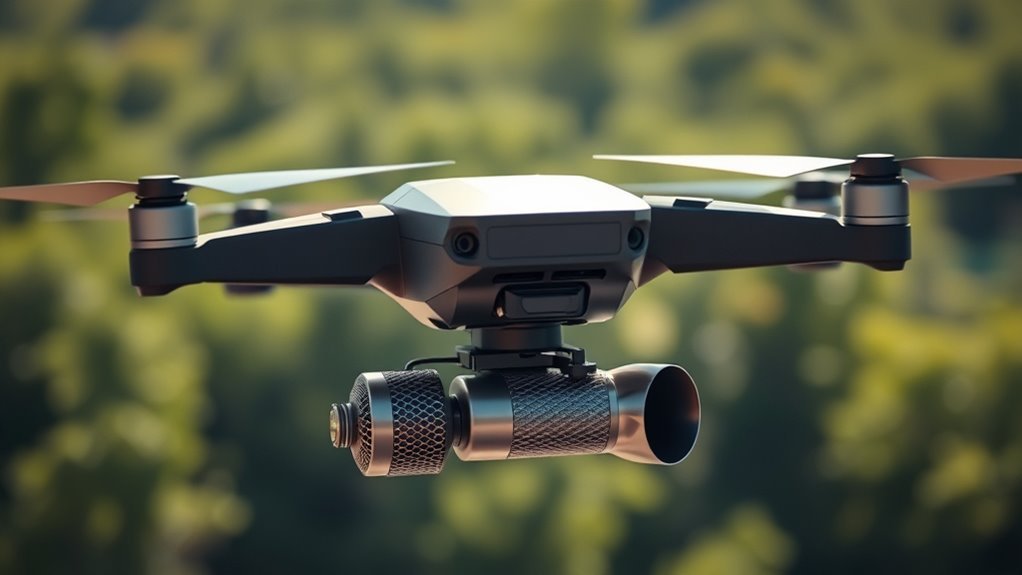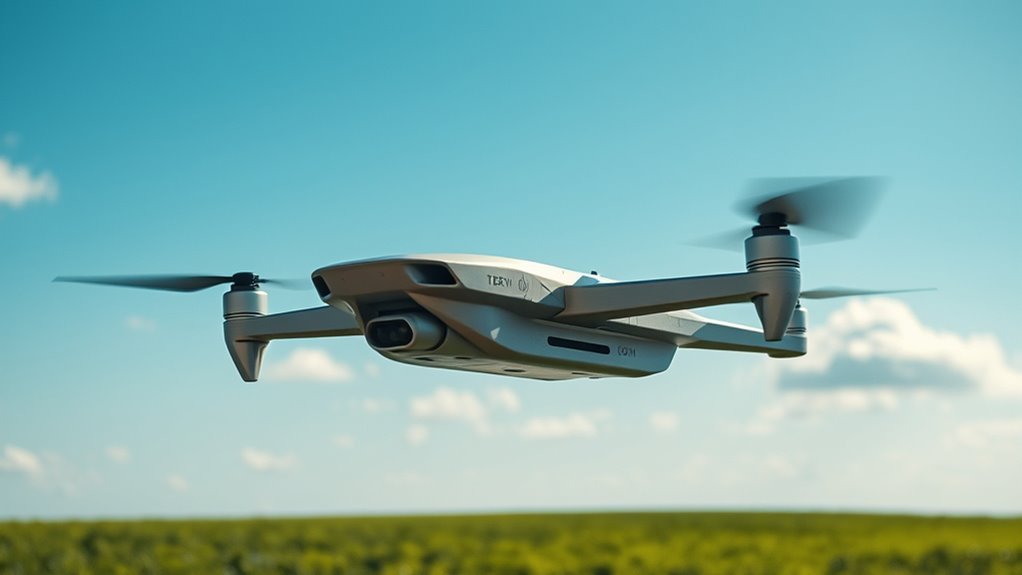A muffler drone is designed to reduce the noise generated by its rotors and motors, using advanced sound-absorbing materials, acoustic chambers, and vibration-dampening components to minimize acoustic pollution and enhance stealth. You’ll find it ideal for operations requiring low noise, like surveillance or environmental monitoring. It balances noise suppression with stable flight dynamics and efficiency, though it presents design challenges such as maintaining lightweight structure and managing heat. Explore further to understand its key features and evolving applications.
Understanding Drone Noise Pollution

Although drones offer remarkable capabilities, their noise emissions pose significant challenges in various environments. You’ll find that drone noise contributes to acoustic pollution, affecting both urban and natural settings. This noise often stems from rotor blade aerodynamics and motor operation, generating disruptive sound frequencies. As a result, drone regulations increasingly address permissible noise levels to balance operational freedom with community comfort. Understanding public perception is vital; many individuals associate drone noise with intrusion and disturbance, which can limit broader acceptance and usage. If you want to maintain freedom in drone operation, it’s important to recognize how noise pollution influences regulatory frameworks and societal attitudes. Addressing these concerns through technological and policy solutions will help guarantee drones coexist harmoniously within your environment.
The Purpose of a Muffler Drone

You’ll find that a muffler drone primarily serves to reduce unwanted noise frequencies generated by your engine’s exhaust system. While it improves acoustic comfort, you need to contemplate how it might affect engine performance and efficiency. Balancing noise reduction with power output is key when evaluating a muffler drone’s purpose.
Noise Reduction Benefits
When you consider the function of a muffler drone, its primary benefit lies in noise reduction by targeting specific sound frequencies generated by engine exhaust systems. By isolating and attenuating these frequencies, the muffler drone minimizes the harsh, resonant tones that can cause discomfort. This precise control over sound frequency helps prevent the amplification of unwanted noise waves within the exhaust pathway. Additionally, vibration dampening plays an important role; it reduces mechanical oscillations that contribute to the overall drone effect. For you, this means a quieter, more refined auditory experience without compromising your sense of freedom on the road. The muffler drone’s ability to systematically manage acoustic energy guarantees noise levels stay controlled, enhancing comfort during extended drives while maintaining that essential connection between rider and machine.
Engine Performance Impact
Since muffler drones primarily address acoustic issues, their impact on engine performance is often misunderstood. You might assume they affect engine efficiency or cause performance degradation, but in reality, their design aims to minimize such effects. When properly engineered, muffler drones provide noise control without compromising power output or fuel economy. Here’s what you should know about their influence on engine performance:
- They reduce specific frequency sound waves without creating back pressure.
- Proper tuning guarantees no loss in combustion efficiency.
- Performance enhancement is negligible but can improve driver comfort.
- They maintain exhaust flow dynamics critical for engine breathing.
- Engine efficiency remains largely unaffected when integrated correctly.
How Muffler Technology Works in Drones

You’ll find that muffler technology in drones primarily relies on noise reduction mechanisms like sound absorption and wave cancellation to minimize acoustic signatures. Key materials, such as specialized foams and composites, are chosen for their ability to dampen vibrations and absorb sound frequencies effectively. Understanding these components helps clarify how mufflers enhance drone stealth without compromising performance.
Noise Reduction Mechanisms
Although drone noise is primarily generated by rapid rotor blade movement and motor vibrations, muffler technology targets these sources through specialized noise reduction mechanisms. By integrating advanced muffler design, you can greatly enhance sound absorption and minimize disruptive noise emissions.
Key noise reduction mechanisms include:
- Resonance chambers that cancel specific sound frequencies
- Perforated tubes that dissipate sound waves internally
- Acoustic baffles redirecting airflow to reduce turbulence noise
- Vibration dampening mounts isolating motor vibrations from the frame
- Multi-layered sound-absorbing materials enhancing attenuation efficiency
These mechanisms work synergistically, allowing you to operate your drone freely while maintaining a low acoustic footprint. Understanding how muffler design manipulates sound propagation empowers you to choose or develop quieter drones, enhancing both stealth and user experience.
Materials Used in Mufflers
The effectiveness of noise reduction in drone mufflers heavily depends on the materials chosen for construction. You’ll find that stainless steel is commonly used due to its durability, corrosion resistance, and ability to withstand high temperatures generated by drone engines. Its structural integrity guarantees the muffler maintains performance over time without degrading. Alongside stainless steel, acoustic insulation materials play an essential role—they absorb and dissipate sound waves, reducing noise emissions considerably. These materials often consist of specialized foams or fibers designed to minimize vibration and resonance within the muffler chamber. By combining stainless steel’s strength with advanced acoustic insulation, muffler drones achieve peak noise suppression, allowing you to operate freely without disturbing surroundings while maintaining efficient engine performance. Choosing the right materials directly influences muffler longevity and noise control effectiveness.
Key Components of a Muffler Drone
Understanding the key components of a muffler drone is essential for diagnosing and addressing the issue effectively. A muffler drone results from specific interactions within the muffler design that amplify certain sound frequencies, detectable through precise noise measurement techniques. To analyze and mitigate this, focus on these components:
- Resonance chambers: These cavities influence sound wave patterns, often causing drone frequencies.
- Perforated tubes: Their placement and size affect exhaust flow and noise modulation.
- Baffles: Designed to disrupt sound waves, baffles can create unwanted tonal frequencies if improperly configured.
- Mounting brackets: Vibrations transmitted through mounts can amplify drone sounds.
- Exhaust pipe diameter: Changes impact flow velocity and pressure, altering noise characteristics.
Benefits of Using Muffler Drones
When you use muffler drones, you’ll notice a significant reduction in operational noise, improving stealth and compliance with noise regulations. This noise efficiency enhances surveillance capabilities by allowing closer proximity without detection. Additionally, muffler drones contribute to minimizing environmental impact through reduced acoustic pollution.
Noise Reduction Efficiency
Although muffler drones are often perceived simply as a nuisance, their role in noise reduction efficiency is both significant and measurable. By analyzing muffler design and targeting specific sound frequencies, these drones mitigate unwanted noise, enhancing operational stealth and environmental comfort. You’ll appreciate how precise engineering transforms a potential disturbance into an asset for freedom of movement.
Key aspects of noise reduction efficiency include:
- Optimized muffler design to disrupt and absorb sound waves
- Targeting dominant sound frequencies that contribute to drone noise
- Reducing acoustic signatures without compromising performance
- Enhancing user control over noise levels in varying environments
- Facilitating quieter drone operation to minimize detection and disturbance
This technical approach empowers you to harness muffler drones effectively while maintaining low noise impact.
Enhanced Surveillance Capability
Since muffler drones operate with markedly reduced noise signatures, you’ll experience enhanced surveillance capabilities that are difficult to achieve with conventional drones. This advancement in drone innovation allows you to conduct covert operations without alerting subjects, greatly improving data collection accuracy. The integration of advanced surveillance technology with muffler systems minimizes acoustic detection risks, enabling longer flight durations in sensitive environments. You’ll benefit from improved situational awareness and real-time monitoring while maintaining operational discretion. This precision enhances your ability to gather intelligence, conduct security assessments, or monitor wildlife unobtrusively. By leveraging muffler drones, you gain a tactical edge, ensuring your surveillance efforts remain undetected and effective—empowering you to maintain freedom in operations where stealth and efficiency are paramount.
Environmental Impact Minimization
Because muffler drones remarkably reduce noise pollution, they play an essential role in minimizing environmental disturbances during operations. By adhering to stringent environmental regulations, these drones guarantee compliance while enabling quieter, more discreet missions. This noise abatement considerably lowers the ecological footprint, allowing you to operate without disrupting wildlife or human communities. The technical design focuses on sound dampening without compromising performance, giving you freedom in diverse environments.
Key benefits include:
- Compliance with noise abatement standards
- Reduced disturbance to wildlife habitats
- Lowered risk of community complaints
- Enhanced operational stealth in sensitive areas
- Contribution to sustainable drone practices
Common Applications for Muffler Drones
When you analyze muffler drones, their most frequent application is in automotive engineering, where they serve to identify and mitigate low-frequency noise issues caused by exhaust system resonances. These muffler drone applications extend to commercial uses such as testing and refining vehicle exhaust systems to guarantee regulatory compliance and enhance driver comfort. You’ll find muffler drones employed in product development environments to detect acoustic anomalies early, enabling targeted modifications that reduce unwanted vibrations and sound emissions. Beyond automotive contexts, muffler drones are utilized in industrial equipment monitoring, where persistent drone noise can indicate mechanical faults. By leveraging muffler drones, you gain precise acoustic diagnostics, empowering you to optimize system performance while maintaining freedom from intrusive noise, which is critical in both consumer satisfaction and environmental noise control.
Comparing Muffler Drones With Standard Drones
Although both muffler drones and standard drones operate within acoustic domains, their purposes, designs, and functional parameters differ considerably. You’ll notice muffler design focuses on acoustic manipulation, aiming to produce continuous, controlled harmonic sounds, whereas standard drones prioritize mobility and varied performance metrics. When comparing drone performance, consider these factors:Muffler drones craft steady acoustic tones, while standard drones emphasize agile flight and versatile performance.
- Muffler drones emphasize sound stability and resonance control.
- Standard drones prioritize flight agility and payload capacity.
- Muffler design integrates acoustic chambers influencing tonal output.
- Standard drone design centers on aerodynamics and propulsion efficiency.
- Muffler drones function as stationary or semi-mobile sound sources; standard drones are typically fully mobile.
Understanding these distinctions helps you appreciate how muffler drones cater to acoustic needs, granting you creative freedom in sound applications, while standard drones focus on versatile aerial tasks.
Challenges in Designing Muffler Drones
Designing muffler drones presents unique challenges that stem from balancing acoustic performance with structural constraints. You must address design challenges rooted in acoustic engineering while guaranteeing the drone remains lightweight and aerodynamic. This balance is critical for preserving flight freedom without sacrificing noise reduction.
| Challenge | Impact | Engineering Focus |
|---|---|---|
| Weight Addition | Reduces flight time | Lightweight materials |
| Noise Attenuation | Limits drone signature | Acoustic insulation |
| Aerodynamic Drag | Affects stability | Streamlined design |
| Heat Dissipation | Prevents component failure | Thermal management |
| Structural Integrity | Ensures durability | Material strength |
Future Trends in Noise Reduction for Drones
As drone applications expand, you’ll see noise reduction technologies evolving to meet stricter regulatory standards and user demands. Future technologies in acoustic engineering will push the boundaries of silent flight, enabling greater operational freedom without compromising stealth or efficiency. Innovations focus on minimizing sound signatures through advanced materials, propulsion redesigns, and real-time noise cancellation.
Key future trends include:
- Integration of metamaterials for sound absorption
- Adaptive rotor blade designs reducing vortex noise
- Active noise control systems embedded in drones
- Lightweight muffler drones with optimized airflow channels
- AI-driven acoustic monitoring for dynamic noise suppression
How to Choose the Right Muffler Drone
Understanding the latest advancements in noise reduction is only part of selecting the right muffler drone for your needs. You must analyze muffler design intricacies and drone selection criteria to guarantee peak performance and minimal acoustic footprint. Focus on compatibility, noise attenuation levels, and weight impact.
| Factor | Description | Importance |
|---|---|---|
| Muffler Design | Aerodynamic, material choice | High |
| Noise Reduction | Decibel reduction capacity | Critical |
| Drone Compatibility | Fits your drone’s specifications | Essential |

